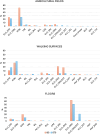Two methods, two views: Integrating phytoliths in thin sections and bulk samples on the urban Dark Earths from the DIVA-site (Antwerp, Belgium)
- PMID: 40163493
- PMCID: PMC11957287
- DOI: 10.1371/journal.pone.0320122
Two methods, two views: Integrating phytoliths in thin sections and bulk samples on the urban Dark Earths from the DIVA-site (Antwerp, Belgium)
Abstract
Traditionally, phytolith analyses are carried out by extraction from bulk (sediment) samples. This technique provides valuable information, not only on the morphological and/or taxonomic assignment of phytoliths, but also on their concentration (quantitative analysis). However, extraction leads to the loss of the (micro-)context in which they are embedded. Over the past 20 years, the study of phytoliths in soil thin sections has proven to be a consistent method. As phytoliths are neither removed from their sedimentary matrix nor artificially concentrated, their analysis provides information on their taphonomical history, but their morphological identification is sometimes limited. Therefore, it seems obvious that the next step to improve phytolith analysis is to combine the two approaches. The aim of this paper is to explore the potential of this integration. For this purpose, we focus on the urban Dark Earth of the DIVA-site (Antwerp, Belgium), with a chronology between the end of the Gallo-Roman Empire and the 11th century AD. Three different stratigraphic units, micromorphologically recognized within the Dark Earth, have been studied. They correspond to an agricultural field, unconsolidated walking surfaces and a floor. Our results confirm the added value of combining the two methods. The possibility of observing the phytoliths in their (micro-)context allowed us to characterize each stratigraphic unit with a particular phytolith assemblage. At the same time, the information derived from the bulk samples overcomes the difficulties in the morphological identification of phytoliths in soil thin sections.
Copyright: © 2025 Alonso-Eguiluz et al. This is an open access article distributed under the terms of the Creative Commons Attribution License, which permits unrestricted use, distribution, and reproduction in any medium, provided the original author and source are credited.
Conflict of interest statement
The authors have declared that no competing interests exist.
Figures









References
-
- Piperno D. Phytoliths. A comprehensive guide for archaeologists and paleoecologists. Altamira Press; 2006.
-
- Vrydaghs L, Devos Y. Phytolith analysis on soil and ceramic thin sections. In: Encyclopedia of global archaeology; 2018. p. 1–7.
-
- Vrydaghs L, Ball T, Devos Y. Beyond redundancy and multiplicity. Integrating phytolith analysis and micromorphology to the study of Brussels Dark Earth. J Archaeol Sci. 2016;68:79–88. doi: 10.1016/j.jas.2015.09.004 - DOI
-
- Albert RM, Weiner S. Study of phytoliths in prehistoric ash layers from Kebara and Tabun caves using a quantitative approach. In: Meunier JD, Colin F, Faure-Denard L, editors. Phytoliths, applications in earth science and human history. Lisse: Balkema; 2001. p. 251–66.
-
- Tsartsidou G, Lev-Yadun S, Albert R-M, Miller-Rosen A, Efstratiou N, Weiner S. The phytolith archaeological record: strengths and weaknesses evaluated based on a quantitative modern reference collection from Greece. J Archaeol Sci. 2007;34(8):1262–75. doi: 10.1016/j.jas.2006.10.017 - DOI
MeSH terms
Substances
LinkOut - more resources
Full Text Sources
Research Materials
Miscellaneous

